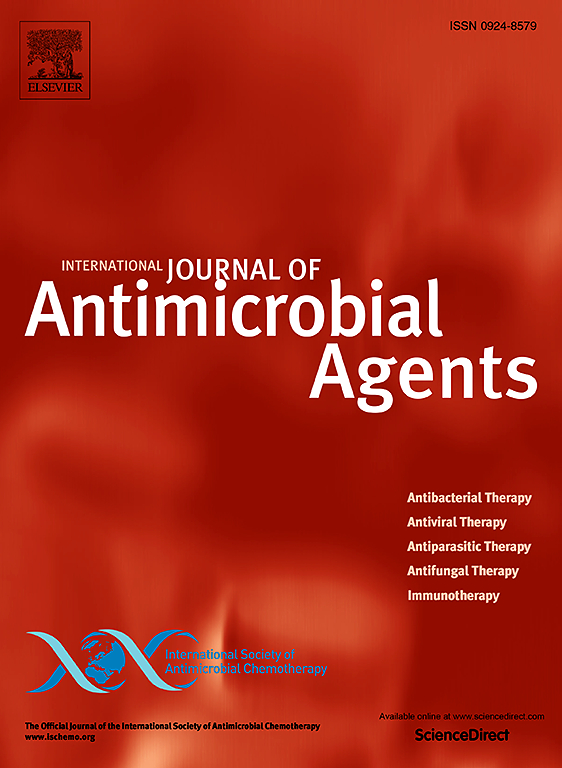HIV-1病毒在antiretroviral-naïve成人血液和精液中的衰变,起始度替格拉韦/拉米夫定与比替格拉韦/恩曲他滨/替诺福韦阿拉芬胺。
IF 4.9
2区 医学
Q1 INFECTIOUS DISEASES
International Journal of Antimicrobial Agents
Pub Date : 2025-01-01
DOI:10.1016/j.ijantimicag.2024.107396
引用次数: 0
摘要
背景:虽然联合配制的多替重力韦和拉米夫定(DTG/3TC)被推荐作为一线抗逆转录病毒治疗(ART),但在antiretroviral-naïve接受DTG/3TC治疗的HIV (PWH)患者中,关于精浆(SP)和血浆(BP)中的病毒衰减以及BP中炎症生物标志物的变化的数据仍然有限。我们进行了一项前瞻性观察队列研究,比较DTG/3TC与bictegravir/emtricitabine/替诺福韦alafenamide (BIC/FTC/TAF)对antiretroviral-naïve PWH病毒衰减动力学和炎症生物标志物变化的影响。方法:新诊断的PWH患者采用BIC/FTC/TAF治疗(n=57)或DTG/3TC治疗(n=43)。分别于ART启动后0、4、12、24和48周采集血压和SP。主要终点是48周时BP和SP中HIV-1病毒的抑制。次要终点包括48周随访期间HIV-1 DNA水平和炎症生物标志物的变化。结果:总体而言,96例(96.0%)完成了48周的随访(DTG/3TC, n=40;BIC / FTC / TAF, n = 56)。在第48周的按方案分析中,BIC/FTC/TAF组和DTG/3TC组BP和SP的病毒抑制率具有可比性(BP, 96.4% vs 100%, p=0.519;标普,100% vs 100%, p>0.999)。两种方案在降低BP (3.0 vs 3.1 log10 copies/mL)和SP (0.9 vs 1.2 log10 copies/mL)中HIV-1 RNA水平方面显示出相似的效果。在48周的随访中,HIV-1 DNA水平的降低和炎症生物标志物的变化没有统计学上的显著差异。结论:这些发现表明DTG/3TC与BIC/FTC/TAF在抑制BP和SP病毒方面的效果相当,并且BP炎症生物标志物的变化相似。本文章由计算机程序翻译,如有差异,请以英文原文为准。

HIV-1 viral decay in blood and semen in antiretroviral-naïve adults initiating dolutegravir/lamivudine vs. bictegravir/emtricitabine/tenofovir alafenamide
Background
Co-formulated dolutegravir and lamivudine (DTG/3TC) is recommended as the first-line antiretroviral therapy (ART); however, the data on the viral decay in seminal plasma (SP) and blood plasma (BP), as well as changes in inflammatory biomarkers in BP, remain limited among antiretroviral-naïve people with HIV (PWH) receiving DTG/3TC. A prospective observational cohort study was conducted to compare the impact of DTG/3TC vs. bictegravir/emtricitabine/tenofovir alafenamide (BIC/FTC/TAF) on viral decay kinetics and changes in inflammatory biomarkers in antiretroviral-naïve PWH.
Methods
Newly diagnosed PWH who initiated BIC/FTC/TAF (n=57) or DTG/3TC (n=43) were enrolled. BP and SP were collected at 0, 4, 12, 24, and 48 weeks after ART initiation. The primary endpoint was viral suppression of HIV-1 in BP and SP at week 48. Secondary endpoints included changes in HIV-1 DNA levels and inflammatory biomarkers over the 48-week follow-up.
Results
Overall, 96 (96.0%) PWH completed the 48-week follow-up (DTG/3TC, n=40; BIC/FTC/TAF, n=56). Viral suppression rates in BP and SP were comparable in the BIC/FTC/TAF and DTG/3TC groups in the per-protocol analyses at week 48 (BP, 96.4% vs. 100%, P=0.519; SP, 100% vs. 100%, P>0.999). Both regimens demonstrated similar effectiveness in reducing HIV-1 RNA levels in BP (3.0 vs. 3.1 log10 copies/mL) and SP (0.9 vs. 1.2 log10 copies/mL). There were no statistically significant differences in the reductions in HIV-1 DNA levels and changes in inflammatory biomarkers over the 48-week follow-up.
Conclusion
These findings indicated comparable effectiveness of DTG/3TC vs. BIC/FTC/TAF in achieving viral suppression in BP and SP, and similar changes in inflammatory biomarkers in BP.
求助全文
通过发布文献求助,成功后即可免费获取论文全文。
去求助
来源期刊
CiteScore
21.60
自引率
0.90%
发文量
176
审稿时长
36 days
期刊介绍:
The International Journal of Antimicrobial Agents is a peer-reviewed publication offering comprehensive and current reference information on the physical, pharmacological, in vitro, and clinical properties of individual antimicrobial agents, covering antiviral, antiparasitic, antibacterial, and antifungal agents. The journal not only communicates new trends and developments through authoritative review articles but also addresses the critical issue of antimicrobial resistance, both in hospital and community settings. Published content includes solicited reviews by leading experts and high-quality original research papers in the specified fields.

 求助内容:
求助内容: 应助结果提醒方式:
应助结果提醒方式:


